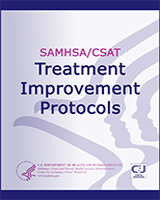NCBI Bookshelf. A service of the National Library of Medicine, National Institutes of Health.
The objective of this TIP, A Guide to Substance Abuse Services for Primary Care Clinicians, is to help physicians, nurses, physician assistants, and advanced practice nurses (nurse practitioners and clinical nurse specialists) screen their patients for substance use disorders, conduct brief interventions for patients in the early stages of problem development, and appropriately refer more severely affected patients for in-depth assessment and treatment. The TIP also gives an overview of the types of treatment available and outlines a primary care clinician's role in aftercare.
This document gives primary care clinicians specific guidance on identifying indications of substance abuse, how to broach the subject with a patient, and what screening and assessment instruments to use. It explains how to perform an office-based brief intervention in which patient and clinician set mutually agreed upon goals and "contract" to stop or cut back the alcohol or other drug use. The elements of in-depth assessments, appropriate referrals, and specialized treatment are discussed. The appendixes to the document include discussions by experts on leading pharmacotherapies for alcohol and other drugs and legal issues of patient confidentiality.
This TIP equips primary care clinicians who may not have any knowledge of the substance abuse field to address this pervasive disease. The physicians, nurses, social workers, researchers, certified alcohol counselors, program directors, and pharmacologists on the Consensus Panel pooled years of research and practice to devise recommendations that can be readily implemented in a busy primary care setting. This TIP represents another step by CSAT toward its goal of bringing national leadership to bear in the effort to improve substance abuse treatment.
Contents
- What Is a TIP?
- Editorial Advisory Board
- Consensus Panel
- Foreword
- Executive Summary and Recommendations
- Chapter 1—Substance Abuse and Primary Care
- Chapter 2—Screening for Substance Use Disorders
- Chapter 3—Brief Intervention
- Chapter 4—Assessment
- Chapter 5—Specialized Substance Abuse Treatment Programs
- Chapter 6—Implementation and Recommendation Summary
- Appendix A—Pharmacotherapy
- Appendix B—Legal and Ethical Issues
- Appendix C—Screening and Assessment Instruments
- Appendix D—Substance Abuse Resources for the Primary Care Setting
- Appendix F—Resource Panel
- Appendix G—Field Reviewers
- Appendix E -- Bibliography
- Tables and Figures*
This publication is part of the Substance Abuse Prevention and Treatment Block Grant technical assistance program. This publication was written under contract number ADM 270-95-0013. Sandra Clunies, MS, ICADC, served as the CSAT Government project officer. Writers were Paddy Cook, Constance Grant Gartner, MSW, Lise Markl, Randi Henderson, Margaret K Brooks, Esq, Donald Wesson, MD, Mary Lou Dogoloff, Virginia Vitzthum, and Elizabeth Hayes. Special thanks go to Daniel Vinson, MD, MSHP, Mim J Landry, Mary Smolenski, CRNP, EdD, MaryLou Leonard, Pamela Nicholson, Annie Thornton, Jack Rhode, Cecil Gross, Niyati Pandya, and Wendy Carter for their considerable contributions to this document.
The opinions expressed herein are the views of the Consensus Panel members and do not reflect the official position of CSAT, SAMHSA, or the U.S. Department of Health and Human Services (DHHS). No official support or endorsement of CSAT, SAMHSA, or DHHS for these opinions or for particular instruments or software that may be described in this document is intended or should be inferred. The guidelines in this document should not be considered substitutes for individualized patient care and treatment decisions.
- NLM CatalogRelated NLM Catalog Entries
- A Guide to Substance Abuse Services for Primary Care CliniciansA Guide to Substance Abuse Services for Primary Care Clinicians
- txid340504[Organism:exp] (10)PMC
- xl11036F02R_1351996 Xenopus ORFeome version 1.0 library Xenopus laevis cDNA clon...xl11036F02R_1351996 Xenopus ORFeome version 1.0 library Xenopus laevis cDNA clone xl11036F02 3', mRNA sequencegi|798033061|gnl|dbEST|79644635|gb| 933.1|Nucleotide
Your browsing activity is empty.
Activity recording is turned off.
See more...
